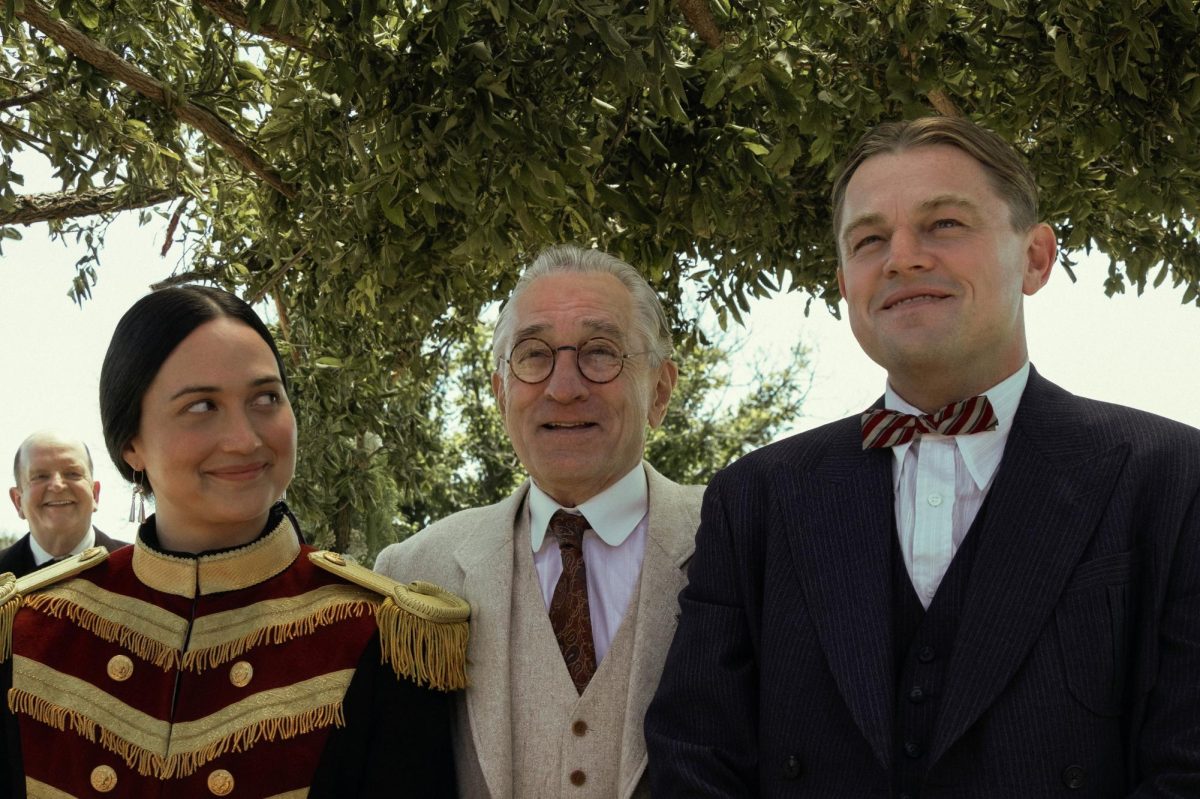Set in the bustling yet tense climate of 1920s Oklahoma oil country, Martin Scorsese’s “Killers of the Flower Moon” is based on a nonfiction book of the same title, which tells the stories of the Osage murders. These racially-motivated killings targeted citizens of the Osage Nation, an Indigenous community in Oklahoma, for their oil wealth and land rights between the 1910s and 1930s. Starring instantly recognizable actors and actresses such as Leonardo DiCaprio, Robert De Niro, Tatanka Means and Lily Gladstone, the film highlights the most notorious of these murders, orchestrated by wealthy entrepreneur and crime kingpin William King Hale (De Niro).
The entire cast delivers compelling performances, capturing the heightened senses of anxiety, fear and determination that were present in both the book and the actual time period. Gladstone in particular offers a powerful and heartbreaking portrayal of Mollie Kyle, the Osage wife of Ernest Burkhart (DiCaprio) and the sister of the women murdered by Hale’s posse. Burkhart, while originally presented as a simple man chasing love and wealth, is later seen to be a shrewd and cruel player involved in several of the murders.
De Niro offers a noteworthy depiction of Hale, who moves directly between the white and Osage communities as a respected man. Later, he is discovered to be the orchestrator of the violence the film is built upon, and we see him fight to hold onto his power and reputation. Cara Jade Myers, who plays Mollie’s sister and murder victim, Anna Brown, gives audiences a dignified and moving portrayal of a woman navigating intersections of race, gender, community, power and addiction in a historical setting.
Clocking in at over three hours, “Killers of the Flower Moon” captivates viewers throughout the entirety of its runtime. Volume changes play a key role in drawing in the audience, as scenes quickly shift from loud and chaotic to somber and unsettlingly calm, with location shifts adding to the gravity of these movements. The film’s setting provides audiences with a glimpse into a changing time as well, with the Osage Nation embracing its oil wealth and expected urbanization, and imparts an alternate view of Indigenous pasts.
Scorsese seeks to highlight Indigeneity in the film, particularly with language and culture. Much of the film’s dialogue, not only amongst the Osage characters, but also with white community members, is in the Osage language and subtitled in English. Osage cultural traditions are also depicted throughout the film, and viewers see the intersections—some organic, others forced—between these practices and those of white America. This dignification of the Osage language and culture not only reflects the historical realities of the time, but also does much justice to the place and power of Indigenous peoples in the American film industry.
Though the film is set in a turbulent Plains environment and centers around murder and money, it does not play out like a typical Western. Naturally, violence is a central part of the movie, and often adds action to an otherwise tranquil setting. However, “Killers of the Flower Moon” also showcases the role of family, community and culture in the lives of the people involved. In particular, we are presented with a community fighting to preserve and strengthen itself amidst a wave of cultural and physical onslaught.
Throughout the film, viewers watch as loyalties are tested and family is built, broken and betrayed while the characters fight for justice and answers. Alongside the action of the film, Scorsese provides viewers with context and closure, leaving no room to wonder how this story ends.
The film’s ending, where Scorsese himself plays a radio show host announcing the details of the aftermath of the murders, was an interesting choice on Scorsese’s behalf. Though all of the facts are presented to the audience, after such a moving and serious film, this sudden shift leaves audiences questioning the remembrance of these murders, and the overall sensationalization of violence against Indigenous peoples in American media.
Overall, “Killers of the Flower Moon” is a very human film. Keeping viewers glued to the screen with its compelling performances and constant suspense, this is a tastefully-made movie. Most importantly, however, it tells a necessary story in our history, and challenges audiences to reimagine the place and power of Indigenous stories in popular media.


